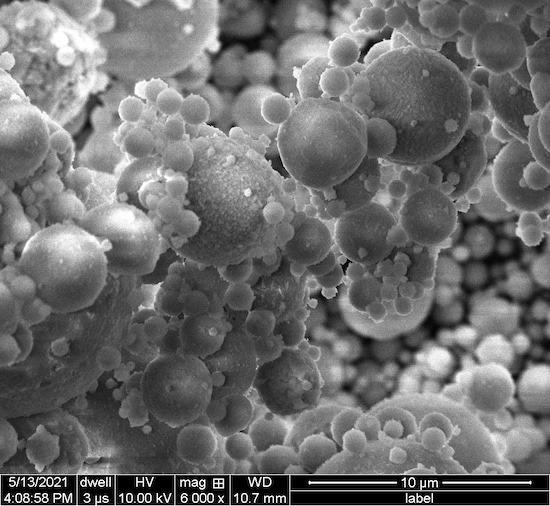Rice University researchers have arrived at a possible solution to deal with rare earth elements (REE) that are hard to get and hard to recycle.
 Microscopic glass spheres found in coal fly ash contain rare earth elements that could be recycled rather than buried in landfills, according to Rice University scientists. Their flash Joule heating process has been adapted to recover the elements. (Image Credit: Tour Group/ Rice University).
Microscopic glass spheres found in coal fly ash contain rare earth elements that could be recycled rather than buried in landfills, according to Rice University scientists. Their flash Joule heating process has been adapted to recover the elements. (Image Credit: Tour Group/ Rice University).
The Rice lab of chemist James Tour has revealed that it has effectively extracted prized REE from waste at quantities sufficiently high to resolve issues for manufacturers while increasing their profits.
The lab’s flash Joule heating process, formulated some years ago to create graphene from any solid carbon source, has currently been used on three sources of REE—bauxite residue, coal fly ash (CFA), and electronic waste—to extract rare earth metals, which have electronic and magnetic properties important to green technologies and advanced electronics.
The scientists state their process is better for the environment by utilizing far less energy and modifying the stream of acid frequently used to extract the elements into a trickle.
The study has been published in the journal Science Advances.
REE are not actually rare. One of them, cerium, is more copious than copper, and all are more plentiful than gold. But these 15 lanthanide elements, along with scandium and yttrium, are broadly distributed and hard to extract from mined materials.
The U.S. used to mine rare earth elements, but you get a lot of radioactive elements as well. You’re not allowed to reinject the water, and it has to be disposed of, which is expensive and problematic. On the day the U.S. did away with all rare earth mining, the foreign sources raised their price tenfold.
James Tour, Professor of Computer Science, Materials Science, and Nanoengineering, and T.T. and W.F. Chao Chair in Chemistry, Rice University
Therefore, there is adequate incentive to recycle whatever has been mined already, he said. A majority of that is heaped or buried in fly ash, the derivative of coal-fired power plants.
“We have mountains of it,” he said. “The residue of burning coal is silicon, aluminum, iron and calcium oxides that form glass around the trace elements, making them very hard to extract.”
Bauxite residue, occasionally referred to as red mud, is the toxic derivative of aluminum production, while electronic waste is from obsolete devices such as smartphones and computers.
Carrying out industrial extraction from these wastes normally involves leaching with strong acid, a laborious, non-green process. In contrast, the Rice lab heats fly ash and other materials (along with carbon black to improve conductivity) to approximately 3,000°C (5,432°F) in a second. The process converts the waste into extremely soluble “activated REE species.”
Tour explained treating fly ash by flash Joule heating “breaks the glass that encases these elements and converts REE phosphates to metal oxides that dissolve much more easily.” Industrial methods use a 15-molar concentration of nitric acid to derive the materials; the Rice method employs a lot milder 0.1-molar concentration of hydrochloric acid that still produces a higher quantity of product.
In experiments directed by postdoctoral researcher and lead author Bing Deng, the scientists discovered flash Joule heating CFA more than doubled the production of most of the REEs using extremely mild acid compared to leaching untreated CFA in powerful acids.
The strategy is general for various wastes. We proved that the REE recovery yields were improved from coal fly ash, bauxite residue, and electronic wastes by the same activation process.
Bing Deng, Postdoctoral Researcher and Study Lead Author, Rice University
The generality of the method makes it particularly promising, Bing stated, as millions of tons of electronic waste and bauxite residue are also generated annually.
The Department of Energy has determined this is a critical need that has to be resolved. Our process tells the country that we’re no longer dependent on environmentally detrimental mining or foreign sources for rare earth elements.
James Tour, Professor of Computer Science, Materials Science, and Nanoengineering, and T.T. and W.F. Chao Chair in Chemistry, Rice University
Tour’s lab had demonstrated flash Joule heating in 2020 to turn petroleum coke, coal, and trash into graphene, the single-atom-thick version of carbon, a process currently being commercialized. The lab has since implemented the process to turn plastic waste into graphene and to derive precious metals from electronic waste.
The study’s co-authors are graduate students Xin Wang and Zhe Wang, alumnus Duy Xuan Luong, undergraduate Robert Carter and Mason Tomson, a professor of civil and environmental engineering. Tour is the T.T. and W.F. Chao Chair in Chemistry as well as a professor of computer science and of materials science and nanoengineering.
The research was supported by the Air Force Office of Scientific Research (FA9550-19-1-0296) and the Department of Energy (DE-FE0031794).
Rare earth elements await in waste
Video credit: Brandon Martin/Rice University